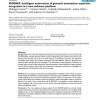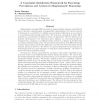646 search results - page 116 / 130 » The human element |
102
click to vote
BMCBI
2006
15 years 14 days ago
2006
Background: Genome sequences vary strongly in their repetitiveness and the causes for this are still debated. Here we propose a novel measure of genome repetitiveness, the index o...
107
Voted
BMCBI
2005
15 years 10 days ago
2005
Background: Two of the main objectives of the genomic and post-genomic era are to structurally and functionally annotate genomes which consists of detecting genes' position a...
117
Voted
BMCBI
2004
15 years 9 days ago
2004
Background: In addition to known protein-coding genes, large amounts of apparently non-coding sequence are conserved between the human and mouse genomes. It seems reasonable to as...
91
Voted
PRESENCE
2007
14 years 12 months ago
2007
Pursuing new display techniques based on insights into human visual perception can reveal new possibilities for visual information devices. Here, we propose a novel information pr...
111
click to vote
JAIR
2010
14 years 11 months ago
2010
Diagrammatic reasoning (DR) is pervasive in human problem solving as a powerful adjunct to symbolic reasoning based on language-like representations. The research reported in this...


